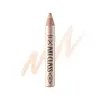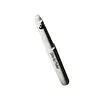What's inside
What's inside
 Key Ingredients
Key Ingredients

 Benefits
Benefits

 Concerns
Concerns

 Ingredients Side-by-side
Ingredients Side-by-side

Mica
Cosmetic ColorantTitanium Dioxide
Cosmetic ColorantIron Oxides
Dimethicone/Divinyldimethicone/Silsesquioxane Crosspolymer
HumectantSilica
AbrasiveNylon-12
Polymethyl Methacrylate
Behenoxy PEG-10 Dimethicone
HumectantIsoamyl Cocoate
Dimethicone
EmollientBoron Nitride
AbsorbentSynthetic Fluorphlogopite
Pentylene Glycol
Skin ConditioningGlyceryl Tribehenate/Isostearate/Eicosandioate
EmollientCaprylyl Glycol
EmollientTriethyl Citrate
MaskingMagnesium Aluminum Silicate
AbsorbentEthylhexylglycerin
Skin ConditioningAlgin
MaskingSodium Polyacrylate
AbsorbentCaprylhydroxamic Acid
Glycerin
HumectantTin Oxide
AbrasiveTocopherol
AntioxidantMica, Titanium Dioxide, Iron Oxides, Dimethicone/Divinyldimethicone/Silsesquioxane Crosspolymer, Silica, Nylon-12, Polymethyl Methacrylate, Behenoxy PEG-10 Dimethicone, Isoamyl Cocoate, Dimethicone, Boron Nitride, Synthetic Fluorphlogopite, Pentylene Glycol, Glyceryl Tribehenate/Isostearate/Eicosandioate, Caprylyl Glycol, Triethyl Citrate, Magnesium Aluminum Silicate, Ethylhexylglycerin, Algin, Sodium Polyacrylate, Caprylhydroxamic Acid, Glycerin, Tin Oxide, Tocopherol
Trimethylsiloxysilicate
EmollientMethyl Trimethicone
Skin ConditioningCalcium Aluminum Borosilicate
Octyldodecanol
EmollientIsohexadecane
EmollientSynthetic Wax
AbrasiveMicrocrystalline Wax
Emulsion StabilisingCalcium Sodium Borosilicate
CI 77891
Cosmetic ColorantCeresin
Emulsion StabilisingDibutyl Lauroyl Glutamide
Skin ConditioningIsododecane
EmollientDibutyl Ethylhexanoyl Glutamide
Skin ConditioningPolyglyceryl-2 Triisostearate
EmulsifyingSilica
AbrasiveDisteardimonium Hectorite
StabilisingTin Oxide
AbrasivePropylene Carbonate
SolventDimethicone
EmollientTocopheryl Acetate
AntioxidantAscorbic Acid
AntioxidantButylene Glycol
HumectantWater
Skin ConditioningAloe Barbadensis Leaf Extract
EmollientTrimethylsiloxysilicate, Methyl Trimethicone, Calcium Aluminum Borosilicate, Octyldodecanol, Isohexadecane, Synthetic Wax, Microcrystalline Wax, Calcium Sodium Borosilicate, CI 77891, Ceresin, Dibutyl Lauroyl Glutamide, Isododecane, Dibutyl Ethylhexanoyl Glutamide, Polyglyceryl-2 Triisostearate, Silica, Disteardimonium Hectorite, Tin Oxide, Propylene Carbonate, Dimethicone, Tocopheryl Acetate, Ascorbic Acid, Butylene Glycol, Water, Aloe Barbadensis Leaf Extract
 Reviews
Reviews

Ingredients Explained
These ingredients are found in both products.
Ingredients higher up in an ingredient list are typically present in a larger amount.
Dimethicone is a type of synthetic silicone created from natural materials such as quartz.
What it does:
Dimethicone comes in different viscosities:
Depending on the viscosity, dimethicone has different properties.
Ingredients lists don't always show which type is used, so we recommend reaching out to the brand if you have questions about the viscosity.
This ingredient is unlikely to cause irritation because it does not get absorbed into skin. However, people with silicone allergies should be careful about using this ingredient.
Note: Dimethicone may contribute to pilling. This is because it is not oil or water soluble, so pilling may occur when layered with products. When mixed with heavy oils in a formula, the outcome is also quite greasy.
Learn more about DimethiconeSilica, also known as silicon dioxide, is a naturally occurring mineral. It is used as a fine, spherical, and porous powder in cosmetics.
Though it has exfoliant properties, the function of silica varies depending on the product.
The unique structure of silica enhances the spreadability and adds smoothness, making it a great texture enhancer.
It is also used as an active carrier, emulsifier, and mattifier due to its ability to absorb excess oil.
In some products, tiny microneedles called spicules are made from silica or hydrolyzed sponge. When you rub them in, they lightly polish away dead skin layers and enhance the penetration of active ingredients.
Learn more about SilicaTin Oxide is an inorganic oxide used to add opacity and volume to a product. In nature, it is already found in mineral form. The main ore of tin is an opaque and shiny mineral called casseterite.
Tin Oxide helps remove translucency in a product, or make it more opaque. Besides adding opacity, tin oxide is used for bulking to add volume.